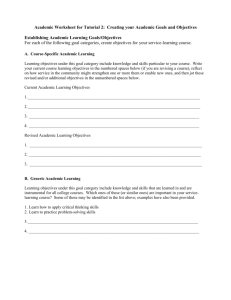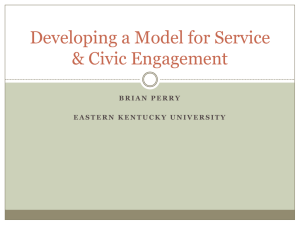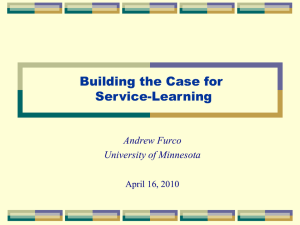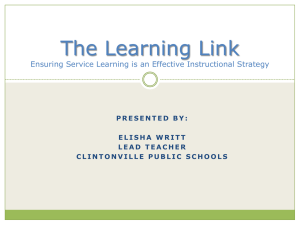Life GPA - Center for Teaching
advertisement
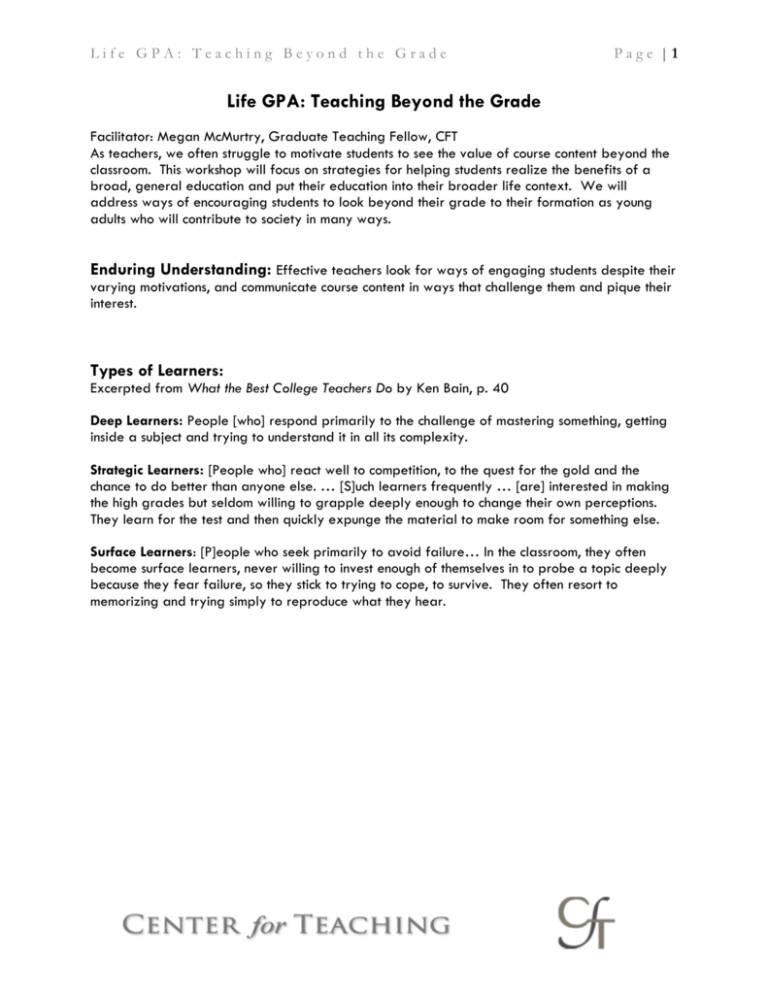
Life GPA: Teaching Beyond the Grade Page |1 Life GPA: Teaching Beyond the Grade Facilitator: Megan McMurtry, Graduate Teaching Fellow, CFT As teachers, we often struggle to motivate students to see the value of course content beyond the classroom. This workshop will focus on strategies for helping students realize the benefits of a broad, general education and put their education into their broader life context. We will address ways of encouraging students to look beyond their grade to their formation as young adults who will contribute to society in many ways. Enduring Understanding: Effective teachers look for ways of engaging students despite their varying motivations, and communicate course content in ways that challenge them and pique their interest. Types of Learners: Excerpted from What the Best College Teachers Do by Ken Bain, p. 40 Deep Learners: People [who] respond primarily to the challenge of mastering something, getting inside a subject and trying to understand it in all its complexity. Strategic Learners: [People who] react well to competition, to the quest for the gold and the chance to do better than anyone else. … [S]uch learners frequently … [are] interested in making the high grades but seldom willing to grapple deeply enough to change their own perceptions. They learn for the test and then quickly expunge the material to make room for something else. Surface Learners: [P]eople who seek primarily to avoid failure… In the classroom, they often become surface learners, never willing to invest enough of themselves in to probe a topic deeply because they fear failure, so they stick to trying to cope, to survive. They often resort to memorizing and trying simply to reproduce what they hear. Life GPA: Teaching Beyond the Grade Page |2 Motivating Students Intrinsic Motivation Intrinsic motivators include fascination with the subject, a sense of its relevance to life and the world, a sense of accomplishment in mastering it, and a sense of calling to it. Students who are intrinsically motivated might say things like the following. “Literature interests me.” “Learning math enables me to think clearly.” “I feel good when I succeed in class.” Advantages: Intrinsic motivation can be long-lasting and self-sustaining. Efforts to build this kind of motivation are also typically efforts at promoting student learning. Such efforts often focus on the subject rather than rewards or punishments. Disadvantages: On the other hand, efforts at fostering intrinsic motivation can be slow to affect behavior and can require special and lengthy preparation. Students are individuals, so a variety of approaches may be needed to motivate different students. It is often helpful to know what interests one’s students in order to connect these interests with the subject matter. This requires getting to know one’s students. Also, it helps if the instructor is interested in the subject to begin with! Source: Matt DeLong and Dale Winter, Learning to Teaching and Teaching to Learn Mathematics: Resources for Professional Development, Mathematical Association of America, 2002, page 163. Extrinsic Motivation Extrinsic motivators include parental expectations, expectations of other trusted role models, earning potential of a course of study, and grades (which keep scholarships coming). Students who are extrinsically motivated might say things like the following. “I need a B- in statistics to get into business school.” “If I flunk chemistry, I will lose my scholarship.” “Our instructor will bring us donuts if we do well on today’s quiz.” Advantages: Extrinsic motivators more readily produce behavior changes and typically involve relatively little effort or preparation. Also, efforts at applying extrinsic motivators often do not require extensive knowledge of individual students. Disadvantages: On the other hand, extrinsic motivators can often distract students from learning the subject at hand. It can be challenging to devise appropriate rewards and punishments for student behaviors. Often, one needs to escalate the rewards and punishments over time to maintain a certain effect level. Also, extrinsic motivators typically do not work over the long term. Once the rewards or punishments are removed, students lose their motivation. Source: Matt DeLong and Dale Winter, Learning to Teaching and Teaching to Learn Mathematics: Resources for Professional Development, Mathematical Association of America, 2002, page 163. Furthermore, research indicates that extrinsic rewards can have a negative impact on intrinsic motivation. In one series of experiments, psychologist Edward Deci had two groups of college students play with a puzzle called Soma. One group of students was paid for each puzzle they solved; the other wasn’t. He found that the group that was paid to solve puzzles stopped solving puzzles as soon as the experiment—and the payment—ended. However, the group that wasn’t paid kept solving the puzzles even after the experiment was over. They had found the puzzles Life GPA: Teaching Beyond the Grade Page |3 intrinsically interesting. Deci argued that the group that had been paid to solve puzzles might have found the puzzles intrinsically interesting as well, but the extrinsic, monetary reward had reduced their intrinsic interest. Source: Ken Bain, What the Best College Teachers Do, Harvard University Press, 2004, pages 3233. A Model of Intrinsic Motivation Deep learners respond well to the challenge of mastering a difficult and complex subject. These are intrinsically motivated students who are often a joy to teach! Strategic learners are motivated primarily by rewards. They react well to competition and the opportunity to best others. They often make good grades but won’t engage deeply with a subject unless there is a clear reward for doing so. They are sometimes called “bulimic learners,” learning as much as they need to do well on a test or exam and then promptly forgetting the material once the assessment is over. Handle strategic learners by avoiding appeals to competition. Appeal to their intrinsic interest in the subject at hand. Design your assignments (tests, papers, projects, etc.) so that deep engagement with the subject is necessary for success on the assignments. Do so by requiring students to apply, synthesize, or evaluate material instead of merely comprehending or memorizing material. Surface learners are often motivated by a desire to avoid failure. They typically avoid deep learning because it they see it as inherently risky behavior. They will often do what it takes to pass an exam or course, but they won’t choose to go beyond the minimum required for fear of failure. Handle surface learners by helping them gain confidence in their abilities to learn and perform. “Scaffold” course material and assignments by designing a series of activities or assignments that build on each other over time in complexity and challenge. Encourage these learners often and help them reflect on what they’ve learned and what they’ve accomplished. Source: Ken Bain, What the Best College Teachers Do, Harvard University Press, 2004, pages 4041. Life GPA: Teaching Beyond the Grade Page |4 Tips for Motivating Students1 Make it real In order to foster intrinsic motivation, try to create learning activities that are based on topics that are relevant to your students' lives. Strategies include using local examples, teaching with events in the news, using pop culture technology (iPods, cell phones, YouTube videos) to teach, or connecting the subject with your students' culture, outside interests or social lives. ([Brozo, 2005] ; McMahon and Kelly, 1996) Provide choices Students can have increased motivation when they feel some sense of autonomy in the learning process, and that motivation declines when students have no voice in the class structure. Giving your students options can be as simple as letting them pick their lab partners or select from alternate assignments, or as complex as "contract teaching" wherein students can determine their own grading scale, due dates and assignments. Kurvink, 1993 Reeve and Hyungshim, 2006 (Perkins 2002, GSA Abstract) Balance the challenge Students perform best when the level of difficulty is slightly above their current ability level. If the task is too easy, it promotes boredom and may communicate a message of low expectations or a sense that the teacher believes the student is not capable of better work. A task that is too difficult may be seen as unattainable, may undermine self-efficacy, and may create anxiety. Scaffolding is one instructional technique where the challenge level is gradually raised as students are capable of more complex tasks. (Wang and Han), [Margolis and McCabe, 2006] [Adams, 1998] Seek role models If students can identify with role models they may be more likely to see the relevance in the subject matter. For example, Weins et al (2003) found that female students were more likely to cite a positive influence with a teacher as a factor for becoming interested in science [Wiens et al, 2003] . In some cases, you can be a role model but it's unlikely that you will connect on that level with everyone in the class due to differences in gender, age and social circles. However there can be many sources of role models, such as invited guest speakers, fellow students or other peers. Use peer models Students can learn by watching a peer succeed at a task. In this context, a peer means someone who the student identifies with, not necessarily any other student. Peers may be drawn from groups as defined by gender, ethnicity, social circles, interests, achievement level, clothing, or age.[Margolis and McCabe, 2006] Establish a sense of belonging People have a fundamental need to feel connected or related to other people. In an academic environment, research shows that students who feel they 'belong' have a higher degree of intrinsic motivation and academic confidence. According to students, their sense of belonging is fostered by an instructor that demonstrates warmth and openness, encourages student participation, is enthusiastic, friendly and helpful, and is organized and prepared for class.[Freeman, Anderman and Jensen, 2007] [Anderman and Leake, 2005] 1 http://serc.carleton.edu/NAGTWorkshops/affective/motivation.html Life GPA: Teaching Beyond the Grade Adopt Page |5 a supportive style A supportive teaching style that allows for student autonomy can foster increased student interest, enjoyment, engagement and performance. Supportive teacher behaviors include listening, giving hints and encouragement, being responsive to student questions and showing empathy for students. Reeve and Hyungshim, 2006 Strategize with struggling students When students are struggling with poor academic performance, low self-efficacy or low motivation, one strategy that may help is to teach them how to learn. That is, to outline specific strategies for completing an assignment, note-taking or reviewing for an exam. [Tuckerman 2003] [Margolis and McCabe, 2006] Life GPA: Teaching Beyond the Grade Page |6 Social Pedagogy: Authentic Audiences Authentic Audiences: “social pedagogies” describe a cluster of teaching practices that “engage students with… an ‘authentic audience’ (other than the teacher) where the representation of knowledge for an audience is absolutely central to the construction of knowledge in a course.”2 Students write more carefully and reflectively when they write for their peers than when they write for their professors. A student will often turn in a paper expecting that a professor will fill in the gaps if she/he skips steps in his/her explanation or if they are unclear in explaining things. Because their peers cannot do this, they have to work harder to clarify. In general, they want to share their ideas with peers and will try harder. Examples: o In-class blogs or wiki o Poster sessions o Letters to the author (of book read in class and evaluated) o Paper presentations What are social pedagogies? Why focus on them?3 Excerpted from Designing for Difficulty: Social Pedagogies as a Framework for Course Design by Randy Bass and Heidi Elmendorf (Georgetown) The rise of Web-based participatory culture, social media, and networked information has put the realm of the “social” at the center of what it means to share and build knowledge in our culture. Yet, we have only begun to understand the ways that the “social life of information” and the social construction of knowledge can reshape the ways we create learning experiences in the formal college curriculum. We believe though that the deepening role of social dimension in learning—which we take broadly to include all representational acts as constitutive of knowledge—is as yet very little understood, not only with respect to technology-enhanced classrooms but broadly across all learning contexts. That is why our approach is to look at a range of teaching contexts from those where digital media tools are central to the course design to those where no digital technologies are involved at all, and hybrid contexts in between. With this in mind, we define social pedagogies as design approaches for teaching and learning that engage students with what we might call an “authentic audience” (other than the teacher), where the representation of knowledge for an audience is absolutely central to the construction of knowledge in a course. Social pedagogies build in iterative cycles of engagement with the most difficult material, and through a focus on authentic audience and representation of knowledge for others, help students deepen their understanding of core concepts by engaging in the ways of thinking, practicing, and communicating in a field. Ideally, social pedagogies strive to build a sense of intellectual community within the classroom and frequently connect students to communities outside the classroom. Our interest in the importance of focusing on the social dimensions of learning can be located at the intersection of three important discourses. On the one hand, social pedagogies are a way of understanding what is often referred to as authentic learning. Authentic learning activities have “real-world relevance,” set problems for students that are “ill-defined” and Randy Bass and Heidi Elmendorf Designing for Difficulty: Social Pedagogies as a Framework for Course Design by Randy Bass and Heidi Elmendorf (https://blogs.commons.georgetown.edu/bassr/social-pedagogies/) 2 3 Life GPA: Teaching Beyond the Grade Page |7 complex, provide opportunities for students to examine and address the task from multiple perspectives, and give students ample opportunities to collaborate, reflect on their learning, and integrate their knowledge in various ways. Secondly, we are interested in the specific learning traits that emerge from these “authentic learning” situations. In particular, we have long hypothesized that social pedagogies are particularly effective at developing traits of “adaptive expertise,” which include the ability of the learner to use knowledge flexibly and fluently, to evaluate, filter and distill knowledge for effect, to translate knowledge to new situations, and to understand the limits and assumptions of one’s knowledge. Equally as important is the cultivation of certain attitudes or dispositions characteristic of adaptive experts, including the ability to work with uncertainty, adapt to ambiguity or even failure, and to feel increasingly comfortable working at the edges of one’s competence. Although these are considered traits of “adaptive expertise,” they are increasingly being seen as essential liberal learning traits and as such the kinds of skills and dispositions that we want to be cultivating in novice learners as early as possible in college. A focus of this project was to explore the ways that social pedagogies might be especially effective at cultivating traits of adaptive expertise with novice learners in contexts typical of general education and liberal education contexts. These kinds of adaptive traits—however valued they may be in the academy in the abstract—are often invisible and elusive in the course design and assessment process. Designing a course that promotes, supports, and perhaps even evaluates these kinds of traits students implies that they have to be ways to make these effects visible—through some form of communication. And making them visible means, as well, means being conscious of them and increasingly reflective about them. This is one of the primary ways we see representation (and the social dimensions of learning) residing at the center of authentic learning (in both process and product). Representation of knowledge for others—whether as an author or maker, a teacher, a discussant or maker of arguments—implies that a learner has to step outside him or herself, to think about audience, context, and impact. Acts of representation are not merely vehicles to convey knowledge; they shape the very act of knowing. We also believe that this approach provides us a set of lenses for learning more about the function of learning in formal classroom environments that start to take on some of the characteristics of Web-based “participatory cultures” where members of a community of practice find strong support for sharing their contributions, where members feel a sense of connectedness to each other, or that at least there is a shared sense of investment in what is being created, and a sense that something “is at stake” in the work being produced, either individually or collectively. These are characteristics shared by many informal learning environments. One of the salient research areas for higher education (and indeed other settings, such as organizational learning) is how to harness the effectiveness of informal learning in the formal curriculum. In short, social pedagogies are ways of seeing how acts of communication and representation connect authentic tasks to learning processes, learning process to adaptive practices, practices to learning environments and intellectual communities, and how the constellation of these elements help students integrate their learning by connecting to larger contexts for knowledge and action. Life GPA: Teaching Beyond the Grade Page |8 Principles Of Good Practice For Service-Learning Pedagogy Excerpted from Howard, Jeffrey, ed., Michigan Journal of Community Service Learning: Service-Learning Course Design Workbook, University of Michigan: OCSL Press, Summer 2001 pp. 16H19. The following ten principles were created by Jeffrey Howard for the Michigan Journal of Community Service in 2001. Howard believes that in order to fully understand and authentically integrate service-learning into coursework, that faculty must adhere to each of these principles equally. Principle 1: Academic Credit is for Learning, Not for Service This first principle speaks to those who puzzle over how to assess students’ service in the community, or what weight to assign community involvement in final grades. In traditional courses, academic credit and grades are assigned based on students’ demonstration of academic learning as measured by the instructor. It is no different in service-learning courses. While in traditional courses we assess students’ learning from traditional course resources, e.g. textbooks, class discussions, library research, etc., in service-learning courses we evaluate students’ learning from traditional resources, from the community service, and from the blending of the two. So, academic credit is not awarded for doing service or for the quality of the service, but rather for the students’ demonstration of academic and civic learning. Principle 2: Do Not Compromise Academic Rigor Since there is a widespread perception in academic circles that community service is a “soft” learning resource, there may be a temptation to compromise the academic rigor in a servicelearning course. Labeling community service as a “soft” learning stimulus reflects a gross misperception. The perceived “soft” service component actually raises the learning challenge in a course. Servicelearning students must not only master academic material as in traditional courses, but also learn how to learn from unstructured community experiences and merge that learning with the learning from other course resources. Principle 3: Establish Learning Objectives It is a service-learning maxim that one cannot develop a quality service-learning course without first setting very explicit learning objectives. This principle is foundational to service-learning. While establishing learning objectives for students is a standard to which all courses are accountable, in fact, it is especially necessary and advantageous to establish learning objectives in service-learning courses. The addition of the community as a learning context multiplies the learning possibilities. To sort out those of greatest priority, as well as to leverage the bounty of learning opportunities offered by community service experiences, deliberate planning of course academic and civic learning objectives is required. Principle 4: Establish Criteria for the Selection of Service Placements Requiring students to serve in any community-based organization as part of a service-learning course is tantamount to requiring students to read any book as part of a traditional course. Faculty who are deliberate about establishing criteria for selecting community service placements will find that students are able to extract more relevant learning from their respective service experiences, and are more likely to meet course learning objectives. We recommend four criteria for selecting service placements: Life GPA: Teaching Beyond the Grade Page |9 1. Circumscribe the range of acceptable service placements around the content of the course (e.g., for a course on homelessness, homeless shelters and soup kitchens are learning appropriate placements, but service in a hospice is not). 2. Limit specific service activities and contexts to those with the potential to meet courserelevant academic and civic learning objectives (e.g., filing papers in a warehouse, while of service to a school district, will offer little to stimulate either academic or civic learning in a course on elementary school education.) 3. Correlate the required duration of service with its role in the realization of academic and civic learning objectives (e.g., one two-hour shift at a hospital will do little to contribute to academic or civic learning in a course on institutional health care). 4. Assign community projects that meet real needs in the community as determined by the community. Principle 5: Provide Educationally Sound Learning Strategies to Harvest Community Learning and Realize Course Learning Objectives Requiring service-learning students to merely record their service activities and hours as their journal assignment is tantamount to requiring student in an engineering course to log their activities and hours in the lab. Learning in any course is realized by an appropriate mix and level of learning strategies and assignments that correspond with the learning objectives for the course. Given that in service-learning courses we want to utilize students’ service experiences in part to achieve academic and civic course learning objectives, learning strategies must be employed that support learning from service experiences and enable its use toward meeting course learning objectives. Learning interventions that promote critical reflection, analysis, and application of service experiences enable learning. To make certain that service does not underachieve in its role as an instrument of learning, careful thought must be given to learning activities that encourage the integration of experiential and academic learning. These activities include classroom discussions, presentations, and journal and paper assignments that support analysis of service experience in the context of the course academic and civic learning objectives. Of course, clarity about course learning objectives is a prerequisite for identifying educationally-sound learning strategies. Principle 6: Prepare Students for Learning from the Community Most students lack experience with both extracting and making meaning from experience and in merging it with other academic and civic course learning strategies. Therefore, even an exemplary reflection journal assignment will yield, without sufficient support, uneven responses. Faculty can provide: 1) learning supports such as opportunities to acquire skills for gleaning the learning from the service context (e.g., participant-observer skills), and/or 2) examples of how to successfully complete assignments (e.g., making past exemplary student papers and reflection journals available to current students to peruse). Principle 7: Minimize the Distinction Between the Students’ Community Learning Role and Classroom Learning Role Classrooms and communities are very different learning contexts. Each requires students to assume a different learner role. Generally, classrooms provide a high level of teacher direction, with students expected to assume mostly a passive learner role. In contrast, service communities usually provide a low level of teaching direction, with students expected to assume mostly an active learner role. Life GPA: Teaching Beyond the Grade P a g e | 10 Alternating between the passive learner role in the classroom and the active learner role in the community may challenge and even impede student learning. The solution is to shape the learning environments so that students assume similar learner roles in both contexts. While one solution is to intervene so that the service community provides a high level of teaching direction, we recommend, for several reasons, re-norming the traditional classroom toward one that values students as active learners. First, active learning is consistent with active civic participation that service-learning seeks to foster. Second, students bring information from the community to the classroom that can be utilized on behalf of othersQ learning. Finally, we know from recent research in the field of cognitive science that students develop deeper understanding of course material if they have an opportunity to actively construct knowledge.7 Principle 8: Rethink the Faculty Instructional Role If faculty encourage students’ active learning in the classroom, what would be a concomitant and consistent change in one’s teaching role? Commensurate with the preceding principle’s recommendation for an active student learning posture, this principle advocates that servicelearning teachers, too, rethink their roles. An instructor role that would be most compatible with an active student role shifts away from a singular reliance on transmission of knowledge and toward mixed pedagogical methods that include learning facilitation and guidance. To re-shape one’s classroom role to capitalize on the learning bounty in service-learning, faculty will find Howard’s 1998 model of “Transforming the Classroom” helpful. This four-stage model begins with the traditional classroom in which students are passive, teachers are directive, an all conform to the learned rules of the classroom. In the second stage, the instructor begins to resocialize herself toward a more facilitative role; but the students, socialized for many years to be passive learners, are slow to change to a more active mode. In the third stage, with the perseverance of the instructor, the students begin to develop and acquire the skills and propensities to be active in the classroom. Frequently, during this phase, faculty will become concerned that learning is not as rich and rigorous as when they are using the more popular lecture format, and may regress to a more directive posture. Over time homeostasis is established, and the instructor and the students achieve an environment in which mixed pedagogical methods lead to students who are active learners, instructors fluent in multiple teaching methods, and strong academic and civic learning outcomes. Principle 9: Be Prepared for Variation in, and Some Loss of Control with, Student Learning Outcomes For faculty who value homogeneity in student learning outcomes, as well as control of the learning environment, service-learning may not be a good fit. In college courses, learning strategies largely determine student outcomes, and this is true in service-learning courses, too. However, in traditional courses, the learning strategies (i.e., lectures, labs, and reading) are constant for all enrolled students and under the watchful eye of the faculty member. In service-learning courses, given variability in service experiences and their influential role in student learning, one can anticipate greater heterogeneity in student learning outcomes and compromises to faculty control. Even when service learning students are exposed to the same presentations and the same readings, instructors can expect that classroom discussions will be less predictable and the content of student papers/projects less homogeneous than in courses without a service assignment. As an instructor, are you prepared for greater heterogeneity in student learning outcomes and some degree of loss of control over student learning stimuli? Life GPA: Teaching Beyond the Grade P a g e | 11 Principle 10: Maximize the Community Responsibility Orientation of the Course This principle is for those who think that civic learning can only spring from the community service component of a course. One of the necessary conditions of a service-learning course is purposeful civic learning. Designing classroom norms and learning strategies that not only enhance academic learning but also encourage civic learning are essential to purposeful civic learning. While most traditional courses are organized for private learning that advances the individual student, service learning instructors should consider employing learning strategies that will complement and reinforce the civic lessons from the community experience. For example, efforts to convert from individual to group assignments and from instructor-only to instructor and student review of student assignments, re-norms the teaching-learning process to be consistent with the civic orientation of service-learning. Life GPA: Teaching Beyond the Grade P a g e | 12 Additional Resources on Motivating Students Web Resources Vanderbilt CFT Teaching Guide on Motivating Students http://cft.vanderbilt.edu/teaching-guides/interactions/motivating-students/ Motivating Students, from Tools for Teaching by Barbara Gross Davis http://teaching.berkeley.edu/bgd/motivate.html Motivating Students from On the Cutting Edge – Professional Development for Geoscience Faculty (National Association of Geoscience Teachers) http://serc.carleton.edu/NAGTWorkshops/affective/motivation.html Derek Bruff’s Blog Posts (CFT Director) http://derekbruff.com/site/blog/category/student-motivation/ Designing for Difficulty: Social Pedagogies as a Framework for Course Design by Randy Bass and Heidi Elmendorf Georgetown University (https://blogs.commons.georgetown.edu/bassr/social-pedagogies/) Vanderbilt CFT Teaching Guide on Service Learning and Community Engagement http://cft.vanderbilt.edu/teaching-guides/teaching-through-community-engagement/ Books (available in CFT library) Bain, K. What the Best College Teachers Do. Cambridge, Mass.: Harvard University Press, 2004. McKeachie, W. J. Teaching Tips. (12th ed.) Lexington, Mass.: Heath, 2006. Life GPA: Teaching Beyond the Grade P a g e | 13 Putting it into Practice… Indentify the goal of your course (or course segment): What do I want them to remember 5 years down the road? What is essential? What are the consequences of being in the world without a proper understanding of ________? How can I identify my student’s concerns? How can I connect material to their life in a meaningful & authentic way? Can I relate this to their lived experience through the use of authentic audience or communitybased learning? If so, how?
